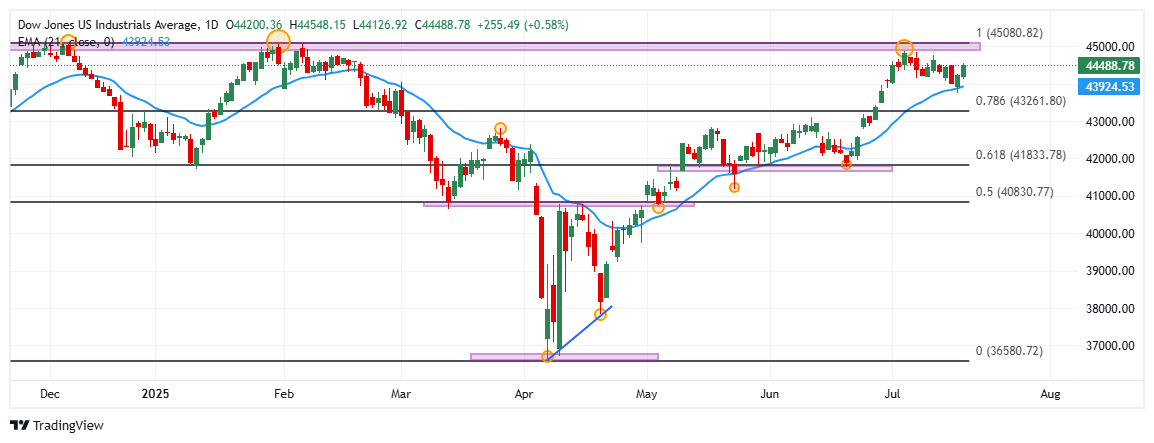- The Dow Jones rises 0.58% today, reaching maximums of the 10 .ulio in 44548.
- The Nasdaq 100 advances 0.78% daily, registering new historical maximums in 23,106.
- The S&P 500 wins 0.60% on Thursday, reaching new historical maximums in 6,303.
- The United States retail sales rise 0.6% in June, above market forecasts.
- Weekly applications for unemployment are located in 221,000, less than 235,000 projected by analysts.
The Dow Jones established a minimum of the day in 44,126, attracting buyers who took the index to maximum of July 10 in 44,548.
The Dow Jones industrial average began negotiations at 44,200, while the Nasdaq 100 technological index opened at 22,882. The S&P 500 began operating in 6,256, registering new historical maximums in 6,303.
The Dow Jones closes in the profit zone supported by The Travelers Companies and Walt Disney Company
The Dow Jones index advances 0.58% in the day, currently quoting over 44,488.
Walt Disney Company (DIS) values rise 1.99% daily, reaching maximums of July 8 at $ 122.39, signing its second consecutive day with profits.
The actions of The Traveler Companies (TRV) earn 3.81% on Thursday, visiting maximums of July 7 in 262.48 $, spinning two consecutive upward sessions.
The Dow Jones rebounds 255 points, reaching maximums of July 10 in 44,548.
The Nasdaq 100 records new historical maximums driven by Pespsico and Shopify
The Nasdaq 100 technological index rebounds 0.78% daily, marking a new historical maximum in 23,106.
Shopify titles (Shop) earn 5.63% in the day, reaching maximum of February 19 at 127.34 $. In the same tune, Pepsico (PEP) shares shoot 7.45% today, reaching April 15 at $ 145.96.
PEP announced its earnings report, obtaining 22.73 billion dollars in revenue compared to 22.27 billion dollars provided by analysts, as well as a gain per share of 2.12 $ compared to the $ 2,029 planned by the market.
The Nasdaq 100 advances 179 points, concluding the day at 23,080.
The S&P 500 reaches new historical maximums after solid economic data from the United States
The US Census Office reported today that retail sales increased 0.6% in June, above 0.1% expected by analysts. This figure is after -0.9% registered in May.
In another front, the weekly applications of unemployment subsidy were located at 221,000 in the week that ended on July 12, below the planned 235,000 and the 228,000 observed in the previous week.
On the other hand, Snap-on Incorporated (SNA) titles rise 7.92% daily, reaching maximum of April 2 in 342.57 $. SNA announced its quarterly report, obtaining income for 1.18 billion dollars compared to the 1.16 billion dollars planned, as well as a profit per share of $ 4.72 compared to the $ 4,631 projected by the market.
Following the upward perspective, the values of Albembarle Corporation (ALB), earn 7.57% on Thursday, reaching maximums not seen since March 26 at $ 76.66, spinning its second consecutive day upwards.
The S&P 500 goes up 37 points, signing a new historical maximum in 6,303.
Technical Analysis of Dow Jones
The Dow Jones formed a support in 41,760, minimum of June 19, in convergence with the recoil at 61.8% of Fibonacci. The following important support is 40,747, a pivot point of May 6. To the north, the next resistance is 44,877, historical maximum reached on July 3.
Dow Jones daily graphics

Dow Jones – Frequently Questions
The Dow Jones Industrial Avenge, one of the oldest stock market indexes in the world, consists of the 30 most negotiated values in the United States. The index is weighted by the price instead of capitalization. It is calculated by adding the prices of the values that compose it and dividing them by a factor, currently 0.152. The index was founded by Charles Dow, also founder of the Wall Street Journal. In recent years it has been criticized for not being sufficiently representative, since it only follows 30 companies, unlike broader rates such as S&P 500.
There are many factors that promote the Dow Jones Industrial Average (DJIA) index. The main one is the added performance of the companies that compose it, revealed in the quarterly reports of business benefits. The American and world macroeconomic data also contribute, since they influence investor confidence. The level of interest rates, set by the Federal Reserve (FED), also influences the DJia, since it affects the cost of credit, on which many companies depend largely. Therefore, inflation can be a determining factor, as well as other parameters that influence the decisions of the Federal Reserve.
Dow’s theory is a method to identify the main trend of the stock market developed by Charles Dow. A key step is to compare the direction of the Dow Jones Industrial Avenge (DJIA) and the Dow Jones Transportation Average (DJTA) and just follow the trends in which both move in the same direction. The volume is a confirmation criterion. The theory uses elements of maximum and minimum analysis. Dow’s theory raises three phases of the trend: accumulation, when intelligent money begins to buy or sell; Public participation, when the general public joins the trend; and distribution, when intelligent money abandons the trend.
There are several ways to operate with the DJ. One of them is to use ETF that allow investors to negotiate the DJ as a single value, instead of having to buy shares of the 30 companies that compose it. An outstanding example is the SPDR Dow Jones Industrial Avenge ETF (day). Future contracts on the DJ allow the specular operators about the future value of the index and the options provide the right, but not the obligation, to buy or sell the index at a predetermined price in the future. Investment funds allow investors to buy a part of a diversified portfolio of DJ values, which provides exposure to global index.
Source: Fx Street
I am Joshua Winder, a senior-level journalist and editor at World Stock Market. I specialize in covering news related to the stock market and economic trends. With more than 8 years of experience in this field, I have become an expert in financial reporting.







